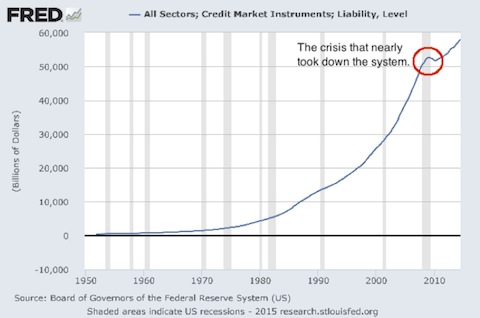| Online: | |
| Visits: | |
| Stories: |
Central Banks Are Beginning to Lose Control
Thus far we’d seen some pretty aggressive moves. The most aggressive was committed by the Bank of Japan, which announced a single QE program equal to 24% of Japanese GDP in April 2013.
However, the SNB was the first Central Bank to actually reach the point at which it had to decide between printing a truly insane amount of money relative to GDP (50%+) or simply giving up.
It chose to give up.
In many ways, the SNB was cornered by the ECB into this situation. I think this is why the SNB decided to make its announcement on a Thursday as opposed to over the weekend (when Central Banks usually announce bad news to minimize the market impact). The SNB wanted to cause mayhem, likely because it was frustrated by the ECB’s upcoming QE program of which the SNB was undoubtedly aware in advance.
This situation has since progressed with an even larger, more important Central Bank buckling to market forces.
That Central Bank is China.
As we’ve noted before, China’s economy is in tatters. At best it is growing around 3.5%. At worst it isn’t growing at all. And with its currency closely linked with the US Dollar (which is in a bull market) Chinese exporters were getting destroyed.
So what did China do? It chose to devalue the Yuan.
In short, a new player is in the global currency war. And it represents the second largest economy in the world. Having said that, we want you to take note of a few lessons from this situation:
Of these, #1 is the most important. Since the mid-‘80s, the general consensus has been that there is no problem too great that Central Banks cannot fix it. This has been the case because most crisis that have occurred during that period were either isolated to a particular market (Asian Crisis, Latin American Crisis, Russian Ruble Crisis, etc.) or a particular asset class (Tech Bubble, Housing Bubble, etc.).
This situation has resulted in less and less volatility in the financial system, combined with increased risk taking on the part of investors. As a result, the necessary deleveraging has never been permitted to occur and the financial system has become increasing leveraged (meaning more and more debt).
You can see this in the below chart revealing total credit market instruments in the US (this only includes investment grade bonds, junk bonds, and commercial paper). The deleveraging of the 2008 crisis which nearly took down the entire financial system was a mere blip in a mountain of debt (and this doesn’t even include US sovereign debt, emerging market debt, derivatives, etc.).
Today, when you include global debt issuance, we are facing a debt super crisis, the likes of which has never existed before: $100 trillion in global bonds, with an additional $555 trillion in derivatives.
Central Banks, by printing money, began a war of competitive devaluation in 2008. This worked fine when they were coordinating their moves to prop the system up from 2009-2011. We even had some coordinated efforts by the Fed and the ECB to push the markets higher in 2012 in order to benefit President Obama’s re-election campaign.
However, 2012 marked the high water mark for Central Bank intervention without political repercussions. From that point onward, all Central Bank began to lose their political capital rapidly.
The significance of these developments cannot be overstated. Central Banks will be increasingly acting against one another going forward. There will more surprises and more volatility across the board. Eventually it will culminate in a Crash that will make 2008 look like a picnic.
Smart investors are preparing now, BEFORE it hits.
http://www.zerohedge.com/news/2015-08-12/central-banks-are-beginning-losing-control
NESARA- Restore America – Galactic News
Source: http://nesaranews.blogspot.com/2015/08/central-banks-are-beginning-to-lose.html





